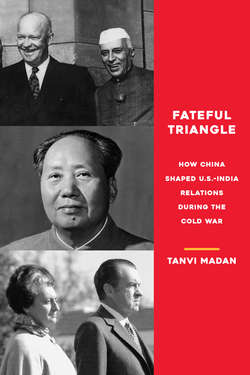Читать книгу Fateful Triangle - Tanvi Madan - Страница 29
Other Problematic Partnerships (1955)
ОглавлениеIndia’s receding intermediary role reduced one source of tension between the US and India, but other irritants had emerged, especially related to their partnerships with others. Negotiations over the UK-driven Baghdad Pact in 1955 exacerbated Indian concerns about associated military aid to Pakistan from nonmember US.228 Nehru believed that, like SEATO, the group might end up having “more bark … than bite,” but the potential consequences made it problematic for India.229 Wanting to focus on development, he did not wish to get into an arms race with Pakistan. But, he told Indian diplomats, it was his reminder to Dulles of the implications for India’s ability to guard its 2,000-mile frontier with China that “of course impressed him much more.”230
That fall, the US relationship with another ally—NATO member Portugal—also strained the US-India relationship. Britain and France had left India, but, despite Indian demands, Lisbon had refused to give up Goa on the western coast of the subcontinent. Dulles, in a joint statement with the Portuguese foreign minister in December 1955, referred to Goa as a Portuguese province instead of a colony as India had labeled the territory. The statement had followed Chinese and Soviet declarations supporting India’s stance on the issue. Cooper later clarified to Nehru that Dulles’s statement indicated neither a final US position on Goa nor that Goa fell within NATO’s purview. But the damage to the US image in India was already done.231
The deteriorating US-India relationship stood in stark contrast to the developing India-Soviet one. Delhi had been trying to improve relations with Moscow since independence. The Soviet Union, though, had given India short shrift. After Stalin’s death, however, as the US had before it, Moscow assigned India a part in its drive to counter its adversaries. To encourage and enable India to play that role, it offered assistance and acceptance. The new bonhomie was evident during visits by Nehru to the Soviet Union in June 1955, and by Nikita Khrushchev and Nikolai Bulganin to India in November–December 1955. In India, the Soviet leaders made a number of offers: more economic assistance at better terms; certain kinds of aid (especially scientific and technical) that Moscow seemed less inhibited about giving than Washington; large infrastructure projects, including in the state-owned sector; trade; military equipment; and support for India’s position on Kashmir and its claim to Goa.232 The availability of a Soviet option was particularly welcome to an Indian leadership looking to diversify the country’s dependence. Moreover, Indian diplomats in Moscow believed that “a little competition” would help India’s case with Washington.233 And while Nehru expected an “angry reaction” from American policymakers, he also thought that Soviet attention would generate among them “a feeling that India [was] even more important than they [had] thought, [and] far greater efforts should be made to win [India to] their side.”234 But, at least in the near term, that was not the impact Soviet aid had on the US.
American policymakers warily watched the India-Soviet interactions. They believed there were limits to how far the new friendship could go, but saw it as a setback. The India-Soviet bonhomie contributed to skepticism within and outside the administration about aiding an India that supported Chinese and Soviet policies.235 Returning from a study mission to India, Representative Robert Byrd (D-WV) said the Soviet leaders’ trip only highlighted that India was not a dependable country. He said that while he had previously supported aid to India, it was time to “let Mr. Nehru and his people know that those who like to run with the hare and hunt with the hounds just can’t get American aid.” Representative Adair agreed, criticizing American and Indian officials urging assistance so that India could beat China in the development race.236 But it was that race that would eventually elicit the more positive American reaction that Nehru had expected.
